20.4: Los aldehídos, cetonas, ácidos carboxílicos y ésteres
- Page ID
- 1974
\( \newcommand{\vecs}[1]{\overset { \scriptstyle \rightharpoonup} {\mathbf{#1}} } \)
\( \newcommand{\vecd}[1]{\overset{-\!-\!\rightharpoonup}{\vphantom{a}\smash {#1}}} \)
\( \newcommand{\id}{\mathrm{id}}\) \( \newcommand{\Span}{\mathrm{span}}\)
( \newcommand{\kernel}{\mathrm{null}\,}\) \( \newcommand{\range}{\mathrm{range}\,}\)
\( \newcommand{\RealPart}{\mathrm{Re}}\) \( \newcommand{\ImaginaryPart}{\mathrm{Im}}\)
\( \newcommand{\Argument}{\mathrm{Arg}}\) \( \newcommand{\norm}[1]{\| #1 \|}\)
\( \newcommand{\inner}[2]{\langle #1, #2 \rangle}\)
\( \newcommand{\Span}{\mathrm{span}}\)
\( \newcommand{\id}{\mathrm{id}}\)
\( \newcommand{\Span}{\mathrm{span}}\)
\( \newcommand{\kernel}{\mathrm{null}\,}\)
\( \newcommand{\range}{\mathrm{range}\,}\)
\( \newcommand{\RealPart}{\mathrm{Re}}\)
\( \newcommand{\ImaginaryPart}{\mathrm{Im}}\)
\( \newcommand{\Argument}{\mathrm{Arg}}\)
\( \newcommand{\norm}[1]{\| #1 \|}\)
\( \newcommand{\inner}[2]{\langle #1, #2 \rangle}\)
\( \newcommand{\Span}{\mathrm{span}}\) \( \newcommand{\AA}{\unicode[.8,0]{x212B}}\)
\( \newcommand{\vectorA}[1]{\vec{#1}} % arrow\)
\( \newcommand{\vectorAt}[1]{\vec{\text{#1}}} % arrow\)
\( \newcommand{\vectorB}[1]{\overset { \scriptstyle \rightharpoonup} {\mathbf{#1}} } \)
\( \newcommand{\vectorC}[1]{\textbf{#1}} \)
\( \newcommand{\vectorD}[1]{\overrightarrow{#1}} \)
\( \newcommand{\vectorDt}[1]{\overrightarrow{\text{#1}}} \)
\( \newcommand{\vectE}[1]{\overset{-\!-\!\rightharpoonup}{\vphantom{a}\smash{\mathbf {#1}}}} \)
\( \newcommand{\vecs}[1]{\overset { \scriptstyle \rightharpoonup} {\mathbf{#1}} } \)
\( \newcommand{\vecd}[1]{\overset{-\!-\!\rightharpoonup}{\vphantom{a}\smash {#1}}} \)
\(\newcommand{\avec}{\mathbf a}\) \(\newcommand{\bvec}{\mathbf b}\) \(\newcommand{\cvec}{\mathbf c}\) \(\newcommand{\dvec}{\mathbf d}\) \(\newcommand{\dtil}{\widetilde{\mathbf d}}\) \(\newcommand{\evec}{\mathbf e}\) \(\newcommand{\fvec}{\mathbf f}\) \(\newcommand{\nvec}{\mathbf n}\) \(\newcommand{\pvec}{\mathbf p}\) \(\newcommand{\qvec}{\mathbf q}\) \(\newcommand{\svec}{\mathbf s}\) \(\newcommand{\tvec}{\mathbf t}\) \(\newcommand{\uvec}{\mathbf u}\) \(\newcommand{\vvec}{\mathbf v}\) \(\newcommand{\wvec}{\mathbf w}\) \(\newcommand{\xvec}{\mathbf x}\) \(\newcommand{\yvec}{\mathbf y}\) \(\newcommand{\zvec}{\mathbf z}\) \(\newcommand{\rvec}{\mathbf r}\) \(\newcommand{\mvec}{\mathbf m}\) \(\newcommand{\zerovec}{\mathbf 0}\) \(\newcommand{\onevec}{\mathbf 1}\) \(\newcommand{\real}{\mathbb R}\) \(\newcommand{\twovec}[2]{\left[\begin{array}{r}#1 \\ #2 \end{array}\right]}\) \(\newcommand{\ctwovec}[2]{\left[\begin{array}{c}#1 \\ #2 \end{array}\right]}\) \(\newcommand{\threevec}[3]{\left[\begin{array}{r}#1 \\ #2 \\ #3 \end{array}\right]}\) \(\newcommand{\cthreevec}[3]{\left[\begin{array}{c}#1 \\ #2 \\ #3 \end{array}\right]}\) \(\newcommand{\fourvec}[4]{\left[\begin{array}{r}#1 \\ #2 \\ #3 \\ #4 \end{array}\right]}\) \(\newcommand{\cfourvec}[4]{\left[\begin{array}{c}#1 \\ #2 \\ #3 \\ #4 \end{array}\right]}\) \(\newcommand{\fivevec}[5]{\left[\begin{array}{r}#1 \\ #2 \\ #3 \\ #4 \\ #5 \\ \end{array}\right]}\) \(\newcommand{\cfivevec}[5]{\left[\begin{array}{c}#1 \\ #2 \\ #3 \\ #4 \\ #5 \\ \end{array}\right]}\) \(\newcommand{\mattwo}[4]{\left[\begin{array}{rr}#1 \amp #2 \\ #3 \amp #4 \\ \end{array}\right]}\) \(\newcommand{\laspan}[1]{\text{Span}\{#1\}}\) \(\newcommand{\bcal}{\cal B}\) \(\newcommand{\ccal}{\cal C}\) \(\newcommand{\scal}{\cal S}\) \(\newcommand{\wcal}{\cal W}\) \(\newcommand{\ecal}{\cal E}\) \(\newcommand{\coords}[2]{\left\{#1\right\}_{#2}}\) \(\newcommand{\gray}[1]{\color{gray}{#1}}\) \(\newcommand{\lgray}[1]{\color{lightgray}{#1}}\) \(\newcommand{\rank}{\operatorname{rank}}\) \(\newcommand{\row}{\text{Row}}\) \(\newcommand{\col}{\text{Col}}\) \(\renewcommand{\row}{\text{Row}}\) \(\newcommand{\nul}{\text{Nul}}\) \(\newcommand{\var}{\text{Var}}\) \(\newcommand{\corr}{\text{corr}}\) \(\newcommand{\len}[1]{\left|#1\right|}\) \(\newcommand{\bbar}{\overline{\bvec}}\) \(\newcommand{\bhat}{\widehat{\bvec}}\) \(\newcommand{\bperp}{\bvec^\perp}\) \(\newcommand{\xhat}{\widehat{\xvec}}\) \(\newcommand{\vhat}{\widehat{\vvec}}\) \(\newcommand{\uhat}{\widehat{\uvec}}\) \(\newcommand{\what}{\widehat{\wvec}}\) \(\newcommand{\Sighat}{\widehat{\Sigma}}\) \(\newcommand{\lt}{<}\) \(\newcommand{\gt}{>}\) \(\newcommand{\amp}{&}\) \(\definecolor{fillinmathshade}{gray}{0.9}\)Habilidades para desarrollar
- Describir la estructura y propiedades de los aldehídos, las cetonas, los ácidos carboxílicos y los ésteres.
Otra clase de moléculas orgánicas contiene un átomo de carbono conectado a un átomo de oxígeno por un doble enlace, comúnmente llamado el grupo carbonilo. El carbono plano trigonal en el grupo carbonilo se puede unir a otros dos sustituyentes que conducen a varias subfamilias (aldehídos, cetonas, ácidos carboxílicos y ésteres) descritas en esta sección.
Los aldehídos y las cetonas
Tanto los aldehídos como las cetonas contienen un grupo carbonilo, un grupo funcional con un doble enlace carbono-oxígeno. Los nombres de los compuestos de aldehídos y las cetonas se derivan usando las reglas de nomenclatura similares a las de los alcanos y alcoholes, e incluyen los sufijos de identificación de clase -os y -ona, respectivamente.

En un aldehído, el grupo carbonilo está unido a al menos un átomo de hidrógeno. En una cetona, el grupo carbonilo está unido a dos átomos de carbono. Como texto, un grupo aldehído se representa como –CHO; una cetona se representa como –C(O)- o –CO–.
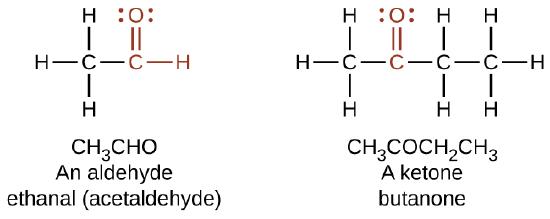
Tanto en los aldehídos como en las cetonas, la geometría alrededor del átomo de carbono en el grupo carbonilo es trigonal plana; el átomo de carbono tiene hibridación sp2. Dos de los orbitales sp2 del átomo de carbono del grupo carbonilo se usan para formar enlaces σ con los otros átomos de carbono o hidrógeno de una molécula. El orbital híbrido sp2 restante forma un enlace σ con el átomo de oxígeno. El orbital p sin hibridar en el átomo de carbono en el grupo carbonilo se superpone a un orbital p en el átomo de oxígeno para formar el enlace π en el doble enlace.
Como el enlace \(\mathrm{C=O}\) en el dióxido de carbono, el enlace \(\mathrm{C=O}\) de un grupo carbonilo es polar (recuerde que el oxígeno es significativamente más electronegativo que el carbono, y los electrones compartidos se atraen hacia el átomo de oxígeno y se alejan del átomo de carbono). Muchas de las reacciones de aldehídos y cetonas comienzan con la reacción entre una base de Lewis y el átomo de carbono en el extremo positivo del enlace polar \(\mathrm{C=O}\) para producir un intermedio inestable que luego sufre uno o más reordenamientos estructurales para formar el producto final (Figura \(\PageIndex{1}\)).
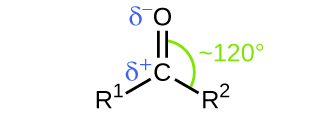
Figura \(\PageIndex{1}\): El grupo carbonilo es polar y la geometría de los enlaces alrededor del carbono central es trigonal plana.
La importancia de la estructura molecular en la reactividad de los compuestos orgánicos se ilustra por las reacciones que producen los aldehídos y las cetonas. Podemos preparar un grupo carbonilo usando la oxidación de un alcohol; en el caso de las moléculas orgánicas, se dice que la oxidación de un átomo de carbono ocurre cuando un enlace carbono-hidrógeno se reemplaza por un enlace carbono-oxígeno. La reacción inversa, reemplazando un enlace carbono-oxígeno por un enlace carbono-hidrógeno, es una reducción de ese átomo de carbono. Recuerde que al oxígeno generalmente se le asigna un número de oxidación -2 a menos que sea elemental o esté unido a un flúor. Al hidrógeno generalmente se le asigna un número de oxidación de +1 a menos que esté unido a un metal. Dado que el carbono no tiene una regla específica, su número de oxidación se determina algebraicamente al factorizar los átomos a los que está unido y la carga total de la molécula o ión. En general, un átomo de carbono unido a un átomo de oxígeno tendrá un número de oxidación más positivo y un átomo de carbono unido a un átomo de hidrógeno tendrá un número de oxidación más negativo. Esto debería alinearse perfectamente con su comprensión de la polaridad de los enlaces C–O y C–H. Los otros reactivos y posibles productos de estas reacciones están más allá del alcance de este capítulo, por eso nos enfocaremos solo en los cambios en los átomos de carbono:

Ejemplo \(\PageIndex{1}\): La oxidación y reducción en la química orgánica
El metano representa la forma completamente reducida de una molécula orgánica que contiene un átomo de carbono. Reemplazando secuencialmente cada uno de los enlaces carbono-hidrógeno con un enlace carbono-oxígeno resultara en un alcohol, luego en un aldehído, luego en un ácido carboxílico (discutido más adelante) y, finalmente, en un dióxido de carbono:
\[\ce{CH4⟶CH3OH⟶CH2O⟶HCO2H⟶CO2}\]
¿Cuáles son los números de oxidación de los átomos de carbono en las moléculas que se muestran aquí?
Solución
En este ejemplo, podemos calcular el número de oxidación (revise el capítulo sobre las reacciones de oxidación-reducción si es necesario) para el átomo de carbono en cada caso (observe cómo esto sería difícil para las moléculas más grandes con átomos de carbono e hidrógeno adicionales, esta es la razón por la cual los químicos orgánicos usan la definición que trata de reemplazar los enlaces C–H por enlaces C–O descrita).
- Para el CH4, el átomo de carbono tiene un número de oxidación de -4 (a los átomos de hidrógeno se les asigna un número de oxidación de +1 y el átomo de carbono lo equilibra al tener un número de oxidación de -4)
- Para el alcohol (en este caso es metanol), el átomo de carbono tiene un número de oxidación de –2 (al átomo de oxígeno se le asigna –2, a los cuatro átomos de hidrógeno a cada uno se le asigna +1, y el átomo de carbono equilibra la suma al tener un número de oxidación de -2; tenga en cuenta que, en comparación con el átomo de carbono en el CH4, este átomo de carbono ha perdido dos electrones, por eso se oxidó)
- Para el aldehído, el número de oxidación del átomo de carbono es 0 (–2 para el átomo de oxígeno y +1 para cada átomo de hidrógeno ya se equilibra en 0, por eso el número de oxidación para el átomo de carbono es 0)
- Para el ácido carboxílico, el número de oxidación del átomo de carbono es +2 (dos átomos de oxígeno cada uno en –2 y dos átomos de hidrógeno en +1)
- Para el dióxido de carbono, el número de oxidación del átomo de carbono es +4 (aquí, el átomo de carbono necesita equilibrar la suma -4 de los dos átomos de oxígeno).
Ejercicio \(\PageIndex{1}\)
Indique si los átomos de carbono marcados en las tres moléculas aquí están oxidados o reducidos en relación con el átomo de carbono marcado en el etanol:

En este caso, no se necesita calcular los estados de oxidación; en su lugar, simplemente compare los tipos de átomos unidos a los átomos de carbono marcados:

- Respuesta a
-
reducido (enlace al átomo de oxígeno reemplazado por enlace al átomo de hidrógeno);
- Respuesta b
-
oxidado (un enlace al átomo de hidrógeno reemplazado por un enlace al átomo de oxígeno);
- Respuesta c
-
oxidado (2 enlaces a átomos de hidrógeno han sido reemplazados por enlaces a un átomo de oxígeno)
Los aldehídos se preparan comúnmente usando la oxidación de los alcoholes cuyo grupo funcional –OH se encuentra en el átomo de carbono al final de la cadena de átomos de carbono en el alcohol:

Los alcoholes que tienen sus grupos –OH en el medio de la cadena son necesarios para sintetizar una cetona, lo que requiere que el grupo carbonilo está unido a otros dos átomos de carbono:

Un alcohol con su grupo –OH unido a un átomo de carbono que no está unido a ningún otro átomo de carbono o a otro átomo de carbono formará un aldehído. Un alcohol con su grupo –OH unido a otros dos átomos de carbono formará una cetona. Si tres carbonos están unidos al carbono unido al –OH, la molécula no tendrá un enlace C–H para ser reemplazado, por eso no será susceptible a la oxidación.
El formaldehído, un aldehído con la fórmula HCHO, es un gas incoloro con un olor acre e irritante. Se vende en una solución acuosa llamada la formalina, que contiene aproximadamente un 37% de formaldehído en peso. El formaldehído provoca la coagulación de las proteínas, por eso mata las bacterias (y cualquier otro organismo vivo) y detiene muchos de los procesos biológicos que provocan la descomposición de los tejidos. En consecuencia, el formaldehído se usa para conservar muestras de tejidos y embalsamar cuerpos. También se usa para esterilizar la tierra u otros materiales. El formaldehído se usa en la fabricación de baquelita, un plástico duro que tiene una alta resistencia química y eléctrica.
La dimetilcetona, CH3COCH3, comúnmente llamada la acetona, es la cetona más simple. Se hace comercialmente fermentando maíz o melaza, o por oxidación de 2-propanol. La acetona es un líquido incoloro. Entre sus muchos usos se utiliza como un solvente para lacas (incluido el esmalte de las uñas), acetato de celulosa, nitrato de celulosa, acetileno, plásticos y barnices; como removedor de pintura y barniz; y como disolvente en la fabricación de productos farmacéuticos y químicos.
Los ácidos y ésteres carboxílicos
El olor del vinagre se causa por la presencia de ácido acético, un ácido carboxílico, en el vinagre. El olor de los plátanos maduros y muchas otras frutas se debe a la presencia de los ésteres, compuestos que se pueden preparar usando la reacción de un ácido carboxílico con un alcohol. Debido a que los ésteres no tienen enlaces de hidrógeno entre las moléculas, tienen presiones de vapor más bajas que los alcoholes y ácidos carboxílicos de los que se derivan (Figura \(\PageIndex{2}\)).
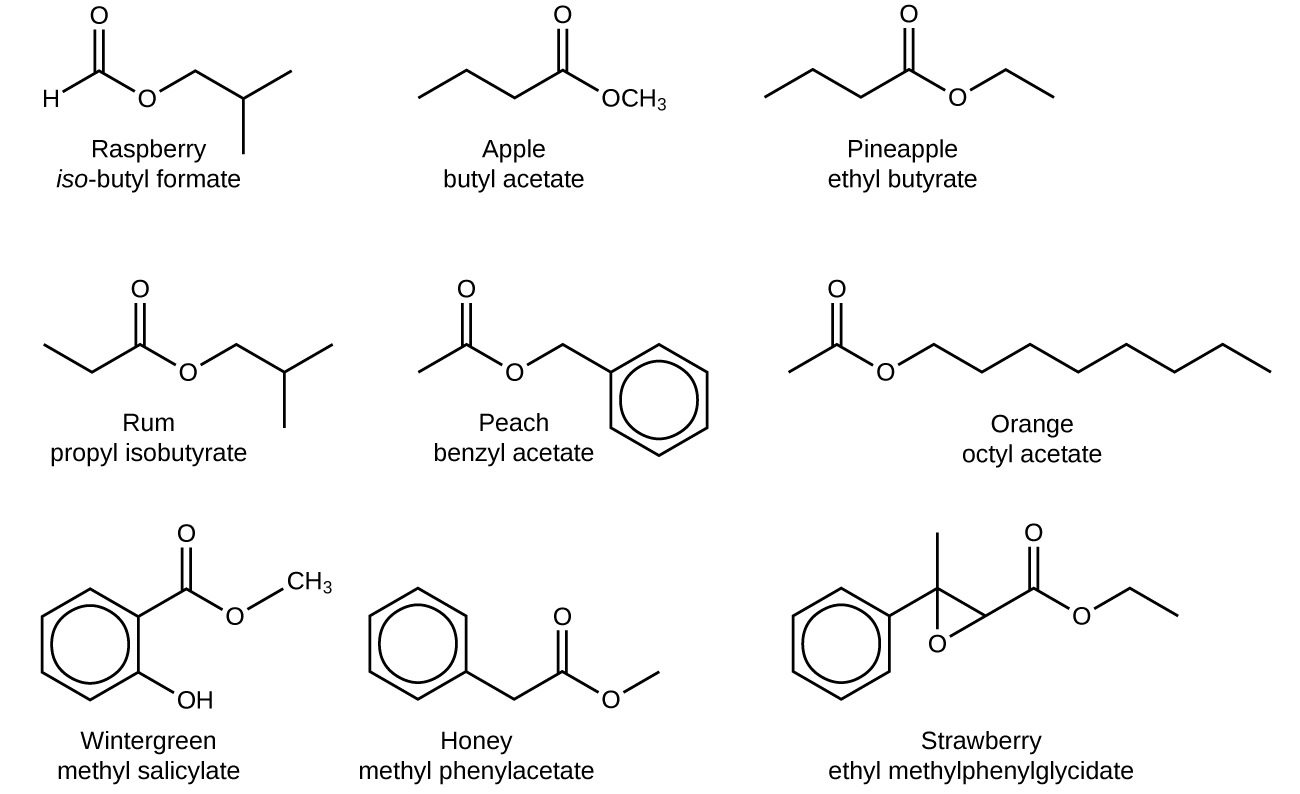
Figura \(\PageIndex{2}\): Los ésteres son responsables por los olores asociados con varias plantas y sus frutos.
Ambos los ácidos carboxílicos y los ésteres contienen un grupo carbonilo con un segundo átomo de oxígeno unido al átomo de carbono en el grupo carbonilo mediante un enlace sencillo. En un ácido carboxílico, el segundo átomo de oxígeno también se une a un átomo de hidrógeno. En un éster, el segundo átomo de oxígeno se une a otro átomo de carbono. Los nombres de los ácidos carboxílicos y ésteres incluyen prefijos que denotan las longitudes de las cadenas de carbono en las moléculas y se derivan siguiendo reglas de nomenclatura similares a las de los ácidos inorgánicos y las sales (consulte estos ejemplos):
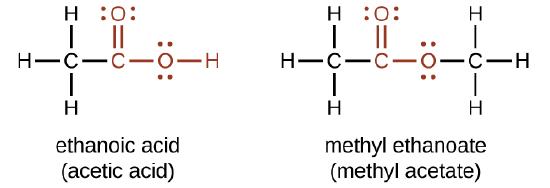
Los grupos funcionales de un ácido y de un éster se muestran en rojo en estas fórmulas.
El átomo de hidrógeno en el grupo funcional de un ácido carboxílico reaccionará con una base para formar una sal iónica:

Los ácidos carboxílicos son ácidos débiles, lo que significa que no están ionizados al 100% en el agua. Generalmente, solo alrededor del 1% de las moléculas de un ácido carboxílico disueltas en el agua se ionizan en un momento dado. Las moléculas restantes no se disocian en solución.
Preparamos los ácidos carboxílicos usando la oxidación de los aldehídos o alcoholes cuyo grupo funcional –OH se encuentra en el átomo de carbono al final de la cadena de átomos de carbono en el alcohol:

Los ésteres se producen usando la reacción de los ácidos con alcoholes. Por ejemplo, el éster acetato de etilo, CH3CO2CH2CH3, se forma cuando el ácido acético reacciona con el etanol:

El ácido carboxílico más simple es el ácido fórmico, HCO2H, conocido desde 1670. Su nombre proviene de la palabra latina formicus, que significa “hormiga”; fue aislado por primera vez usando la destilación de las hormigas rojas. Es parcialmente responsable del dolor y la irritación de las picaduras de las hormigas y avispas, y es responsable por un olor característico de las hormigas que a veces se puede detectar en sus nidos.
El ácido acético, CH3CO2H, constituye un 3-6% de vinagre. El vinagre de sidra se produce al permitir que el jugo de manzana fermente sin oxígeno presente. Las células de levadura presentes en el jugo llevan a cabo las reacciones de fermentación. Las reacciones de fermentación cambian el azúcar presente en el jugo a etanol y luego a ácido acético. El ácido acético puro tiene un olor penetrante y produce dolorosas quemaduras. Es un excelente solvente para muchos compuestos orgánicos e inorgánicos, y es esencial en la producción del acetato de celulosa, un componente de muchas fibras sintéticas como el rayón.
Los olores y sabores distintivos y atractivos de muchas flores, perfumes y frutas maduras se deben a la presencia de uno o más ésteres (Figura \(\PageIndex{3}\)). Entre los ésteres naturales más importantes se encuentran las grasas (como la manteca de cerdo, el sebo y la mantequilla) y los aceites (como los aceites de linaza, algodón y oliva), que son ésteres del alcohol trihidroxílico glicerina, C3H5(OH)3, con ácidos carboxílicos grandes, como el ácido palmítico, CH3(CH2)14CO2H, ácido esteárico, CH3(CH2)16CO2H y ácido oleico, \(\mathrm{CH_3(CH_2)_7CH=CH(CH_2)_7CO_2H}\). El ácido oleico es un ácido insaturado; contiene un doble enlace \(\mathrm{C=C}\). Los ácidos palmítico y esteárico son ácidos saturados que no contienen dobles o triples enlaces.
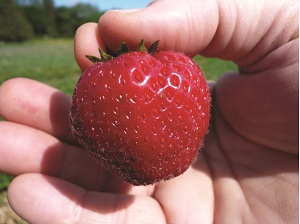
Figura \(\PageIndex{3}\): Se han identificado más de 350 moléculas volátiles diferentes (muchos miembros de la familia de los ésteres) en las fresas. (crédito: Rebecca Siegel)
Resumen
Los grupos funcionales relacionados con el grupo carbonilo incluyen el grupo –CHO de un aldehído, el grupo –CO– de una cetona, el grupo –CO2H de un ácido carboxílico y el grupo –CO2R de un éster. El grupo carbonilo, un doble enlace carbono-oxígeno, es la estructura clave en estas clases de moléculas orgánicas: los aldehídos contienen al menos un átomo de hidrógeno unido al átomo de carbono del carbonilo, las cetonas contienen dos grupos de carbono unidos al átomo de carbono del carbonilo, ácidos carboxílicos contienen un grupo hidroxilo unido al átomo de carbono del carbonilo, y los ésteres contienen un átomo de oxígeno unido a otro grupo de carbono conectado al átomo de carbono del carbonilo. Todos estos compuestos contienen átomos de carbono oxidados en relación con el átomo de carbono de un grupo alcohol.
Glosario
- aldehído
- compuesto orgánico que contiene un grupo carbonilo unido a dos átomos de hidrógeno o un átomo de hidrógeno y un sustituyente de carbono
- grupo carbonilo
- átomo de carbono doble unido a un átomo de oxígeno
- ácido carboxílico
- compuesto orgánico que contiene un grupo carbonilo con un grupo hidroxilo unido
- ester
- compuesto orgánico que contiene un grupo carbonilo con un átomo de oxígeno unido que está unido a un sustituyente de carbono
- cetona
- compuesto orgánico que contiene un grupo carbonilo con dos sustituyentes de carbono unidos a él
Contribuyentes y atribuciones
Paul Flowers (Universidad de Carolina del Norte - Pembroke), Klaus Theopold (Universidad de Delaware) y Richard Langley (Stephen F. Austin Universidad del Estado) con autores contribuyentes. Contenido del libro de texto producido por la Universidad de OpenStax tiene licencia de Atribución de Creative Commons Licencia 4.0 licencia. Descarge gratis en http://cnx.org/contents/85abf193-2bd...a7ac8df6@9.110)."
Ana Martinez (amartinez02@saintmarys.edu) contribuyó a la traducción de este texto.


